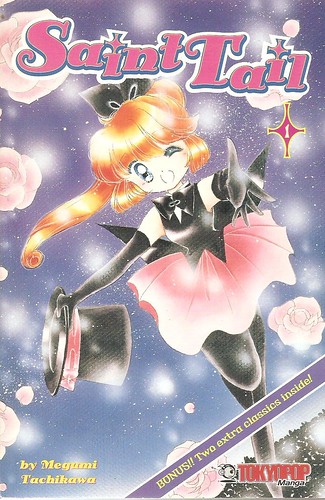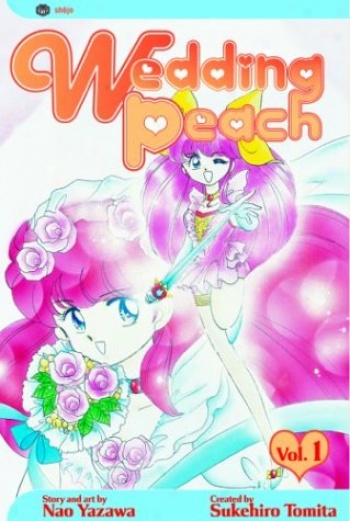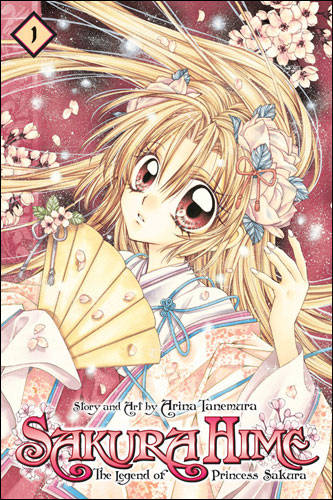SAINT TAIL (Kaito Seinto Teru), by Megumi Tachikawa. First published in 1995, and first published in North America in 2001.
PLOT:
Meimi Hanaka is a seemingly ordinary student at her Catholic junior high, but she has a secret life. She learns of crimes through her best friend and novice nun, Seira, and uses that information to steal back stolen goods under the guise of Saint Tail, using the athletics and speed she inherited from her ex-phantom thief mother and the tricks and diversions learned from her stage magician father. Of course, her thefts do not go unnoticed, in particular by one Asuka Jr, the son of a police detective who is determined to be the one to catch Saint Tail. Meimi must maintain a balance between her nighttime pursuits and her daytime deflections to keep Asuka Jr. from discovering the truth.
STORY:
As noted above, Saint Tail is unusual in that it combines the magical girl and phantom thief genres, but it's also unusual in that it's a magical girl story that really isn't a magical girl story. After all, most magical girls receive their powers from supernatural sources, like dead wizards or intergalactic civilizations or fairies or angels or whatever. Here, Meimi is only magical in that she uses stage magic and sleight of hand to pull of her exploits - everything else comes from either her own mind or strength. It's a far closer fit to your typical phantom thief story, where noble thieves steal in the name of righting crimes or protecting others from harmful goods. It's also unusual to find a magical girl series so heavily tied to religion, to the point where her sidekick is a literal novice (even if the mangaka flat out admits that becoming a nun doesn't work the way they do here). They even say a prayer before each theft. Meimi's not the most complex of characters - she's a bit spunky and headstrong, and that's about it, and even then she gets more development than the rest of the cast.
I do like how the volume built up the conflict between Meimi and Asuka Jr. At first he's played as more of a comedic foil to Saint Tail, always falling just short of catching her and raving how next time he will get her. As the volume progresses, he becomes much more of a romantic foil to Meimi, as his desire to capture Saint Tail transforms into a strange sort of crush on her. It actually leads up to an oddly sweet moment involving a phone booth at the end. Honestly, by volume's end I was more invested in their odd little cat-and-mouse game than in Saint Tail's exploits.
There are a couple of side stories after the last chapter, earlier works from the mangaka. The first is a Little Mermaid-esque about a morning glory who wishes herself to become a girl so that she can win the love of an ice cream vendor. The second is about a universe where the heavens must literally be kept in tune, and the romantic schemes of a witch-in-training nearly throw everything off. The first story was frankly too strange of a concept for my taste, and the erstwhile heroine was extremely passive. The second story feels more like a half-baked idea, and the concept honestly has some potential for a longer story. It's more of a satisfying read than the first story, but it's also very rushed, which hurts the overall quality.
So, Saint Tail is a magical girl story that isn't quite a magical girl story, and a phantom thief story that's more about the romance than the thievery. It may not tidily fit into genre definitions and it's not a terribly deep or complex work, but I was surprised to find that I really enjoyed it, in part because it chose to walk the thin line between genres.
ART:
The artwork is very typical for 1990s shoujo, in that it is very heavily chibi-fied. All the characters are short, squat, bobbleheaded, with big poofs of hair and bigger, shinier eyes. Also true to 1990s shoujo, it's rather busy looking, with the panels packed in the pages like sardines and layered over one another with abandon. Thankfully, the artwork is drawn rather delicately and screentones and effects are kept to a minimum, which keeps things from descending into sheer visual chaos. Panels tend to be on the small and tightly focused side, at least until Meimi goes a-thieving, at which point they expand much like the balloons and confetti around her. Overall, the artwork is very much of its time, but those who don't mind a more old school look to their shoujo will not find too much to complain about here.
PRESENTATION:
Being an older Tokyopop release, the volume is flipped. The only extras are the aforementioned short stories and some author's notes.
RATING:
 While the art is rather conventional for the time this manga was created, Saint Tail does manage to create a surprisingly timeless and enjoyable twist on both magical girl and phantom thief.
While the art is rather conventional for the time this manga was created, Saint Tail does manage to create a surprisingly timeless and enjoyable twist on both magical girl and phantom thief.This series was released by Tokyopop. All 7 volumes were released, and all are currently out of print.
You can purchase manga like this and much more through RightStuf.com!








